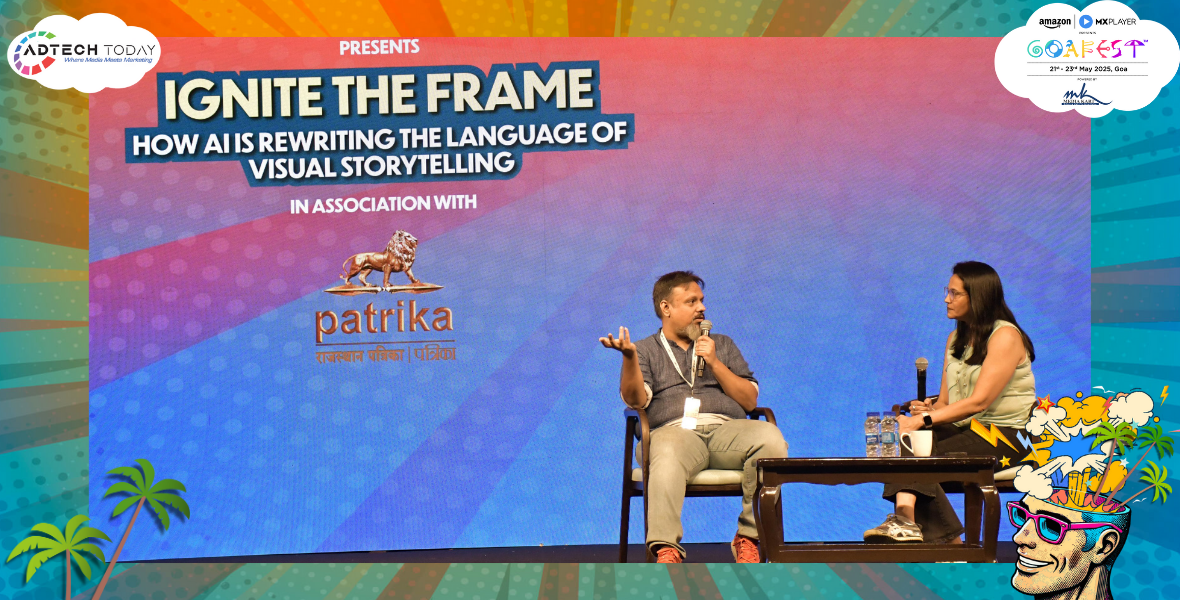
On Day 3 of Goafest 2025, the spotlight was on how Artificial Intelligence is rapidly changing the way visual stories are told. In a powerful keynote titled ‘How AI is Rewriting the Language of Visual Storytelling’, Vivek Anchalia, Founder & CEO of Amazing Indian Stories’, shared his insights on how AI is not just a tool, but a game-changer for the future of filmmaking and advertising. The session was followed by an engaging fireside chat with Lulu Raghavan, President, APAC at Landor.
Anchalia opened with a clear message—AI is transforming every step of the visual storytelling process. From idea to execution, the way we plan and produce stories is faster, cheaper, and often more creative. He explained how AI-generated spec ads now go beyond traditional animatics, offering better clarity on both visuals and narrative. Production decks that used to take hours to prepare can now be built in minutes using AI. One smart slide can now show actor looks, mood, lighting, costume, and even the setting—all with the help of intelligent tools like IPM (Integrated Production Modules) are now powered by AI to reduce the prep time from hours to minutes.
One major takeaway was the cost advantage. AI eliminates the need for physical locations, large crews, and heavy equipment. This opens the door for brands to produce more campaigns, more often—something that was earlier limited by tight budgets.
Anchalia’s upcoming film Naisha became the highlight of the keynote. Created entirely with AI—except for the music—it’s a proof-of-concept that shows how a full-length film can be crafted using AI tools. From AI-generated drone shots of locations like Uttarakhand to entire mood films, the possibilities seem endless. Yet, he made it clear: AI doesn’t replace the filmmaker. It is enabling vision with greater scale and fewer compromises.
In the fireside chat, Lulu Raghavan brought a brand and strategy lens to the discussion. The duo discussed how AI, while cutting costs, still requires skilled creators. AI artists today charge based on their expertise, and agencies continue to play a vital role in understanding brands, culture, and consumer mindsets. Agencies now have more powerful ways to pitch ideas, as AI helps bring concepts to life with visuals and data—but the real value still lies in human insight, like understanding the brand’s identity, culture, and what truly connects with consumers.
They also explored where AI still falls short—especially in music. While generic sound effects can be created easily, emotionally powerful scoring still needs the human touch. Anchalia used human composers in Naisha to keep the film’s rhythm and emotional depth intact.
Interestingly, both speakers agreed that AI cannot yet match the rhythm or signature style of iconic filmmakers. Whether it’s the punchy pace of Tarantino or the heartfelt storytelling of Rajkumar Hirani, human creativity remains at the core.
The session closed on a forward-looking note. Anchalia encouraged creatives to dive into AI through self-learning, online communities, and hands-on experimentation. He pointed out that while formal courses are beginning to emerge in schools like ISDI and IID, curiosity remains the best teacher.
“Don’t fear AI,” he said. “Explore it. Use it to do what was impossible yesterday.”
Lulu Raghavan summed it up perfectly: “AI is still underhyped. Those who understand its storytelling power early will shape the next creative revolution.”
Read more: Day 2 – Spotlight On Creative Specialist Agencies At Abby Awards 2025, Goafest